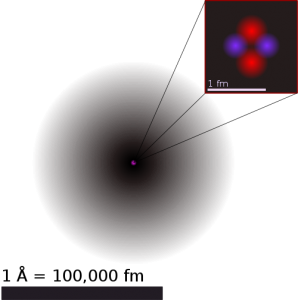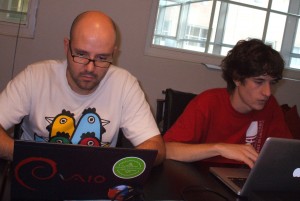#OKFest Open Science and Culture Hackday – Project 1 pyBOSSA Feynman’s Flowers
This morning saw the start of the world’s biggest ever open knowledge meeting and following an inspiring opening session 40 odd hackers descended on the OKFest MAKE space to collaborate on building apps and tools to open up scientific and cultural data sets. The open science crowd was about 15 strong and quickly settled on three projects to focus on throughout the day.
We had our friendly mascot Chuff to help us on the way, sporting his own conference badge:
Creating a pyBOSSA App: Feynman’s Flowers
Daniel Lombraña González and Quentin Mazars-Simon are leading development of Feynman’s Flowers, a pyBOSSA app to crowdsource measurement of how individual molecules stick to surfaces. Read on for more details!
Spintronics with Individual Molecules
Traditional electronic devices work by moving charge around a circuit. This has produced astounding results over the last half century, but we are now at a point where further reducing the size of circuit elements is difficult because it would create too much heat in too small a space.
Our research group is studying magnetic molecules to understand how they can be used to make the smallest possible “spintronic” devices, in which charge (electronic) and spin (magnetic) properties can be used together. In the future, this would allow us to make devices that can do more and also use less energy.
As a simple example, we may be able to use the magnetic orientation of one molecule (the direction in which its internal compass needle points) to store a single bit (0 or 1) of information: this would potentially increase the storage density on hard drives by 100x.
How You Can Help: Measure How Molecules Stick to Surfaces
Using a special kind of “microscope”, operating at close to absolute zero temperature and based on the quantum mechanical principle of tunneling, we can measure single molecules on surfaces.
Many of a molecule’s magnetic properties are determined by how it binds (sticks) to the surface. For example, a group in Japan found that the magnetic stability energy of a molecule could change by 50% just by a 15˚ rotation in its binding angle.
It is therefore crucial for us to measure the distribution of binding angles of a particular molecule on a given surface. This will allow us to compare our results with theoretical predictions to better understand their properties. That’s where you come in …
The App
Data on the centre of attached molecules and their angle must be determined by hand as there is no reliable algorithm. the Feynman’s Flowers app will allow users to determine the centre of the attached molecule and its angle allowing researchers to analyse the data digitally.
What Did We Do?
We’re nearly there! Daniel and Quentin have the app online and with a few tweaks it should be fully up and running within the next day!
You can have a go and also check out the code if you’re keen to see under the bonnet or adapt the code to your own needs.
[Atom diagram from Wikimedia Commons under CC-BY-SA 3.0. All other images under CC-BY]




Leave a Reply